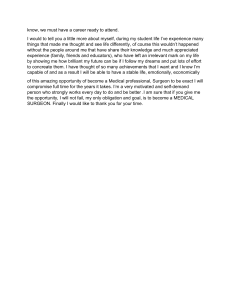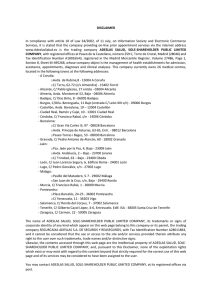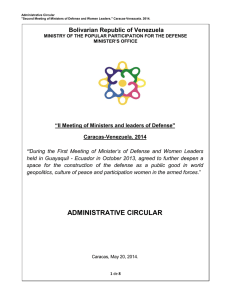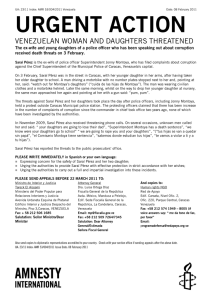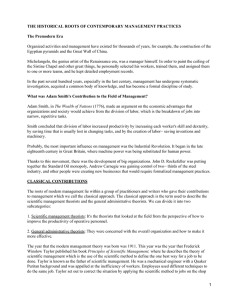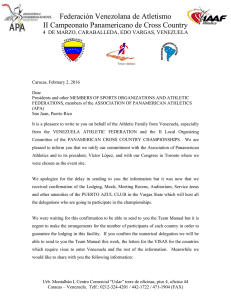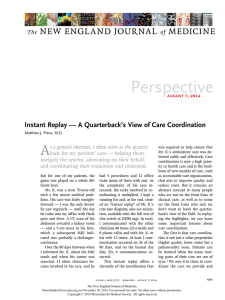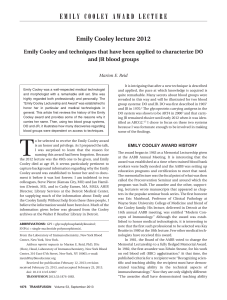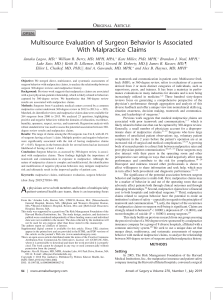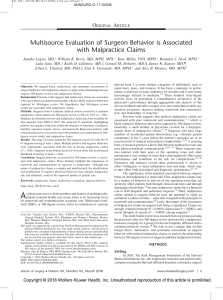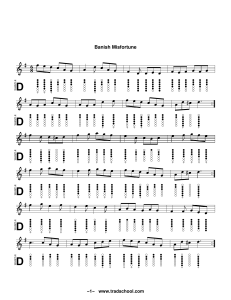Christiaan Barnard: The Surgery as a Show?
Anuncio
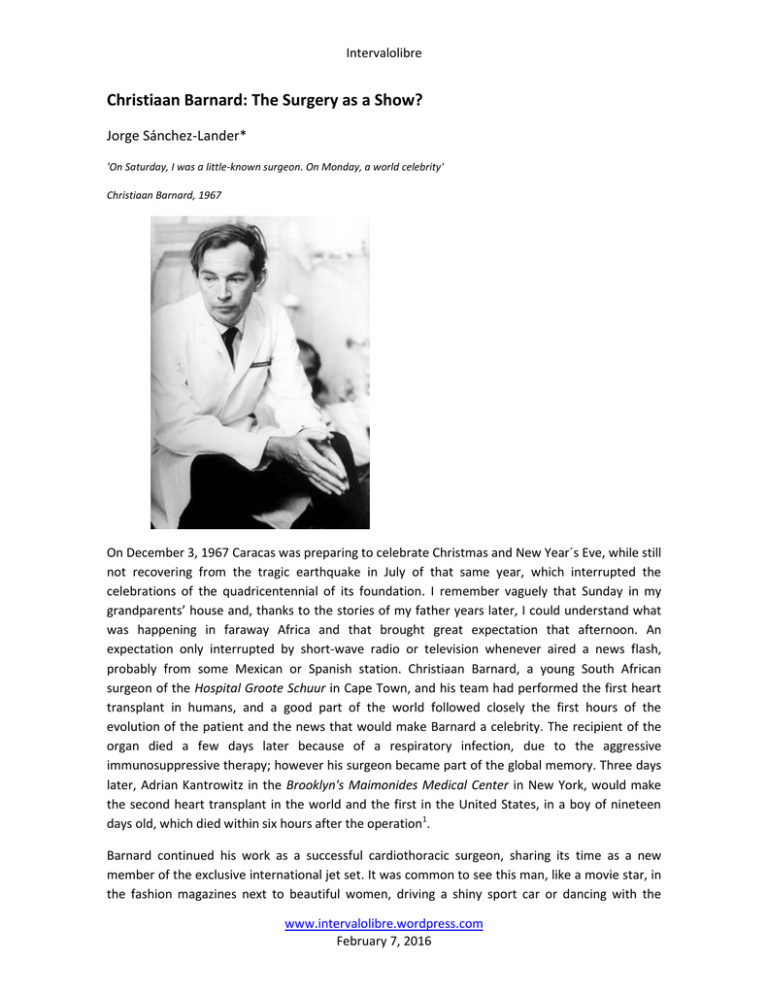
Intervalolibre Christiaan Barnard: The Surgery as a Show? Jorge Sánchez-Lander* 'On Saturday, I was a little-known surgeon. On Monday, a world celebrity' Christiaan Barnard, 1967 On December 3, 1967 Caracas was preparing to celebrate Christmas and New Year´s Eve, while still not recovering from the tragic earthquake in July of that same year, which interrupted the celebrations of the quadricentennial of its foundation. I remember vaguely that Sunday in my grandparents’ house and, thanks to the stories of my father years later, I could understand what was happening in faraway Africa and that brought great expectation that afternoon. An expectation only interrupted by short-wave radio or television whenever aired a news flash, probably from some Mexican or Spanish station. Christiaan Barnard, a young South African surgeon of the Hospital Groote Schuur in Cape Town, and his team had performed the first heart transplant in humans, and a good part of the world followed closely the first hours of the evolution of the patient and the news that would make Barnard a celebrity. The recipient of the organ died a few days later because of a respiratory infection, due to the aggressive immunosuppressive therapy; however his surgeon became part of the global memory. Three days later, Adrian Kantrowitz in the Brooklyn's Maimonides Medical Center in New York, would make the second heart transplant in the world and the first in the United States, in a boy of nineteen days old, which died within six hours after the operation1. Barnard continued his work as a successful cardiothoracic surgeon, sharing its time as a new member of the exclusive international jet set. It was common to see this man, like a movie star, in the fashion magazines next to beautiful women, driving a shiny sport car or dancing with the www.intervalolibre.wordpress.com February 7, 2016 Intervalolibre Princess Grace in Monte Carlo, privileges reserved to the great bullfighters of the era, Princes and wealthy merchants. In 1969 he writes One Life, whose Spanish version I read being a medicine student, not only for the interest generated by this character, logically, but at the insistence of my father to make me know the story of how a humble boy had become an international star. It was hard to understand how a surgeon in a third world country achieved the most important surgical feat of the moment, above the large American, Soviet, or European welfare and research centres. Criticism of this risky event became evident in very short time. The doctors Norman Shumway of Stanford University and Richard Lower of the Medical College of Virginia had worked since the end of the 1950s on canines models, managing to control the technical details of the intervention, but he had not yet raised venture in humans because there was no effective way to control the dreaded tissue rejection. In fact, the Food and Drug Administration had vetoed this intervention as long as does not solve this issue. In Memorias de un cirujano del corazón2 written by the cardiovascular surgeon and Venezuelan University Professor Rubén Jaén Centeno, tells part of a conversation that he had with his friend Dr. Shumway: Christian Barnard made us a 15-day visit to see our new technique of transplantation in dogs. Now you can imagine our surprise and disappointment, when a few months later that operation was launched in humans. Our work of years was ignored and there has been a completely wrong approach of the problem. In 1960, when I presented the first results of animal heart transplants at a Congress in the city of San Francisco in the Auditorium there were only five people, including me and the imaging technician. Nobody gave the slightest attention to our method and everything was considered a fantasy. For us it has been a very hard experience, but we have faith in the future. For large research centers, it was so difficult to assimilate both the temerity to have initiated this surgical intervention without having proper immunosuppressants, and the inexplicable bon vivant behavior of the South African surgeon. In a conversation between Professor Jaén Centeno and Dr. Michael De Bakey, renowned cardiovascular surgeon of the Methodist Hospital in Houston, he asked for an opinion, and Jaén said that it had been an act of boldness that had put at risk the prestige of Barnard. In an angry form Bakey replied: Prestige? What prestige? These people had none to risk and perhaps that´s why they embarked on this adventure. Prestige had all who founded this specialty, and that´s the reason why we couldn´t afford performing an operation that was intended to fail, sooner rather than later, by the problem of rejection. After this first transplant, many attempts, most of them unfortunate, were recorded in several parts of the world. Unexperienced centers insisted in taking part in the canopies of the time, regardless of considering scientifically the topic of rejection. Meanwhile Barnard, after making a second transplant in January 1968 whose receptor survived a year and a half, was still enjoying his great fame and set out to address invitations around the www.intervalolibre.wordpress.com February 7, 2016 Intervalolibre world. In 1968 he was received almost like a head of State in Caracas by President Raúl Leoni and awarded the Andrés Bello Medal. When he visited the Auditorium of the Hospital Universitario of Caracas, before starting his lecture, in the midst of a phenomenal tumult a nurse pounced for stamping a kiss and dozens of people packed to request his autograph. By the same date, at a Congress of Cardiology held in Lima, concurred Dr. Jaén Centeno and Denton Cooley, one of the most prestigious cardiovascular surgeons of Houston school and who led the unit of surgery cardiothoracic of the St. Luke's Episcopal Hospital. On that occasion Cooley tells a fact that Jaén recounts in his book: At the Congress of Lima it came something that was going to require too much work. At the exit of the Bolivar Hotel was a great crowd and I was approached by a young woman to ask for an autograph. I indulged her, but when he saw the paper, I could appreciate that something weird happened and yelled at me: you are not Dr. Barnard? To the answer that I was Denton Cooley, she crumpled the paper and threw it to the ground. Rubén, at that moment I swore that I would do more transplants than anyone else and more quickly in the coming months. The demons of vanity had unleashed. The theme of rejection had not been resolved yet and many specialists fiercely criticized this crazy race, which resulted in many deaths because of the rejection. Powerful motor of ambition was moving in fast, erratic manner without any control. A year later Jaén Centeno, who had firmly and openly criticized this conduct, talked to Cooley again, and the Texan said: I have read your work on transplants and know that you've opposed them because it still has not solved the problem of rejection. The Lima incident made me take part in the race that launched so many people disqualified in search of prestige. You were right. I wish I would have expected the immune resources to improve, because thus it should not repent today of this series of interventions that taught us but, at the same time, have demoralized us. Barnard, gripped by arthritis withdrew in 1983. In 1984 he had to suffer the suicide of his son André, after the divorce of his parents. He had made about 150 heart transplants throughout his workout, and despite the view of his detractors, for many he catalyzed advances in the cardiovascular surgery we know today. After his retirement he devoted himself to research on tissue ageing and to the recovery of wildlife in South Africa. In 1993 he published, again poking the legend of his turbulent history, The Second Life, an autobiographical volume in which recounts his career and the dozens of envied romantic adventures, including the one with the beautiful Gina Lollobrigida. The controversially celebrated Christiaan Barnard died, at the age of 78, by an asthmatic crisis in September 2001, at a hotel in the seaside resort of Pafos on the sunny island of Cyprus. Caracas, February 6 2016 * Service of Gynecology Oncology of the Institute of Oncology Dr. Luis Razetti and Clínica Santa Sofía, Caracas, Venezuela. www.intervalolibre.wordpress.com February 7, 2016 Intervalolibre References 1) 2) Mark Howard. How to save a dying heart. http://www.pbs.org/newshour/rundown/how-to-save-a-dyingheart/ Diciembre 3 de 2013 Jaén Centeno, Rubén. Memorias de un cirujano del corazón. Monte Ávila Editores, Caracas, 1991. www.intervalolibre.wordpress.com February 7, 2016
